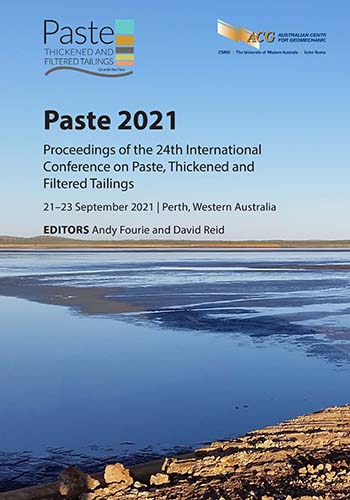Dam break analysis for BRDA 5 at Worsley Alumina Refinery

|
Authors: McPhail, GI; DiDonna, P; Ugaz, R |
DOI https://doi.org/10.36487/ACG_repo/2115_16
Cite As:
McPhail, GI, DiDonna, P & Ugaz, R 2021, 'Dam break analysis for BRDA 5 at Worsley Alumina Refinery', in AB Fourie & D Reid (eds), Paste 2021: Proceedings of the 24th International Conference on Paste, Thickened and Filtered Tailings, Australian Centre for Geomechanics, Perth, pp. 177-200, https://doi.org/10.36487/ACG_repo/2115_16
Abstract:
South32 Worsley Alumina Pty Ltd operates several bauxite residue storage facilities at their refinery in Western Australia. The bauxite residue slurry is thickened and pumped onto the storage facilities which are constructed on an upstream basis using compacted earthfill embankments. BRDA 5 is the newest of the residue storage facilities, established in 1999, and has a current maximum height of embankment slope of 42 m, of which a compacted earthfill starter embankment makes up the first 22 m. Since 2010, the residue has been treated after deposition using amphirols, which assist in dewatering and compacting the residue. As part of their residue management commitments, Worsley undertook a dam break analysis entailing a review of all available geotechnical testing data, a fault-event analysis to evaluate the probability of removal of support to the residue through slope instability, overtopping, geotechnical piping or failure of a buried structure leading to liquefaction of the residue and a dam break. To model the flow of the liquefied residue, pilot-scale dam break testing was carried out from which estimates of the rheology of the residue were made. The rheology has been incorporated into a flow slide model that applies stream power entropy theory to define the energy changes due to viscous effects and frictional resistance. Benchmarking of the results against modelling using computational fluid dynamics has been made. This paper presents an overview of the dam break assessment process and results that covers a liquefaction potential assessment, a semi-quantified risk assessment based on a fault-event analysis approach, rheological testing of liquefied consolidated residue in a specially developed box rheometer and probabilistic modelling of the dam break, the outflow hydrograph, and the flow inundation areas. It is concluded that incorporation of rheology representative of liquefied consolidated residue in dam break modelling results in significantly reduced prediction of inundation area.
Keywords: dam break, flow slide, liquefaction, fault-event tree, rheology, stream power entropy
References:
Blight, GE, Robinson, ME & Diering, JAC 1981, ‘The flow of slurry from a breached tailings dam’, Journal of the South African Institute of Mining and Metallurgy.
Heller, V, Hager, WH & Minor, HE 2009, ‘Landslide generated impulse waves in reservoirs: basics and computation’, Mitteilungen 211, Versuchsanstalt fur Wasserbau, Hydrogie und Glaziologie (VAW), Zurich.
McPhail, G 1995, Prediction of the Beaching Characteristics of Hydraulically Placed Tailings, PhD thesis, University of the Witwatersrand, Johannesburg.
McPhail, GI 2014, ‘Using small scale flumes to determine rheology at low shear rates’, in S Barrera (ed.), Proceedings of the 2nd International Seminar on Tailings Management, Gecamin, Santiago.
McPhail, G 2015, ‘Probabilistic dam break assessment and flow slide analysis for tailings storage facilities’, Proceedings of the 3rd International Seminar on Tailings Management, Gecamin, Santiago.
Robertson, PK 2016, ‘Cone penetration test (CPT)-based soil behaviour type (SBT) classification system — an update’, Canadian Geotechnical Journal, vol. 53, no. 12,
Sadrekarimi, A 2014, ‘Effect of the mode of shear on static liquefaction analysis’, Journal of Geotechnical and Geoenvironmental Engineering, vol. 140, issue 12.
Schneider, JA, Hotstream, JN, Mayne, PW & Randolf, MF 2012, ‘Comparing CPTUQ–FandQ–Du2/sv09soil classification charts’, Geotechnique Letters 2, vol. 2, no. 4, pp. 209–215.
Ugaz, R, & McPhail, G 2021, ‘Determination of the rheology of liquefied bauxite residue using a pilot scale dam break test’, Proceedings of the 7th International Conference on Tailings Management, Gecamin, Santiago.
© Copyright 2025, Australian Centre for Geomechanics (ACG), The University of Western Australia. All rights reserved.
View copyright/legal information
Please direct any queries or error reports to repository-acg@uwa.edu.au
View copyright/legal information
Please direct any queries or error reports to repository-acg@uwa.edu.au





